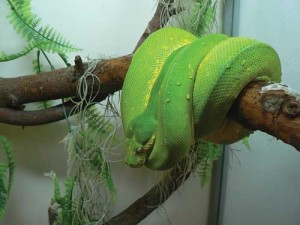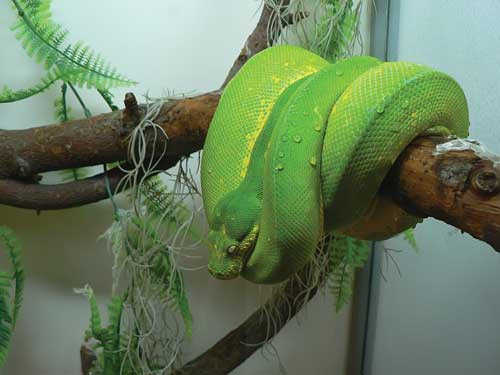The Age of Antiquated Aquariums Is Over
Erik J. Martin //November 1, 2014//
 Welcome to a whole new era of enclosures, a time when reptile owners no longer have to settle for stuffy, inflexible, heavy, rectangular glass habitats to house their pets in thanks to a greater variety of innovative herp dwellings now offered by manufacturers.
Welcome to a whole new era of enclosures, a time when reptile owners no longer have to settle for stuffy, inflexible, heavy, rectangular glass habitats to house their pets in thanks to a greater variety of innovative herp dwellings now offered by manufacturers.
“Modern consumers desire to find more attractive habitats so they can showcase the animals in their homes instead of the garage or basement,” said Daniel Bzdyl, director of business development for BioBubble Pets, makers of a new line of curved cages for reptiles. “The need for space-saving yet effective and attractive design has never been greater.”
Consequently, the conventional aquarium has been given significant upgrades and facelifts, said Sean Raines, director of marketing, equipment, for the aquatics division of United Pet Group, the manufacturer of Tetrafauna products like the Deluxe ReptoHabitat tank.
“The traditional glass aquarium has been upgraded with vents for better air circulation and more secure tops to keep the reptile safe and give the owner peace of mind,” Raines said.
Additionally, manufacturers have incorporated “features that make it easier to interact with the environment, monitor it and conduct maintenance. This allows the reptile owner to focus more on the experience.”
One Size Doesn’t Always Fit All
Ask Frank Indiviglio, herpetologist and consultant for online retailer That Fish Place – That Pet Place in Lancaster, Pa. and he’ll tell you that the most significant contemporary trend in reptile residences is the availability of a variety of habitats specifically designed for particular reptile and amphibian species, often with differentiation between types.
“These specialized enclosures address the needs of reptiles and amphibians in ways not possible with typical aquariums,” said Indiviglio.
One good example is Zoo Med’s ReptiBreeze open air screen cage, designed for small species of Old World chameleons, juvenile green iguanas and other arboreal species of lizards, such as geckos and anoles. This lightweight and portable cage, sporting a large front door for easy access and a bottom door for simpler removal of substrate is almost all screen with a thin metal frame, allowing for better ventilation.
“Poor ventilation—as seen with screen-topped glass aquariums—is a major reason why certain species that need both moist air along with ventilation, including many chameleons, green tree pythons and emerald tree boas, often fail to thrive,” Indiviglio said. “Ventilation is also essential in keeping desert-adapted tortoises and lizards healthy, which are subject to fungal skin and lung infections in stagnant or moist air situations.”
Exo Terra meanwhile, now offers several sizes of glass terrariums that are ventilated at the top and along a front window, allowing for ideal air flow. These habitats provide dual front-opening doors, a raised bottom frame to more easily accommodate a substrate heater or heat cable, waterproof base and deeper ground surface than typical aquariums, providing desert- and ground-dwelling reptiles and amphibians plenty of room.
Plastic and Fantastic
While many habitats are still made of glass and showcase a square or rectangle design, plastic and acrylic enclosures available today are enticing customers with round shapes. For instance, BioBubble Pets offers a brand new line of curved modular habitats, including the BioBubble Terra, which consists of a circular unibody base that anchors a clear acrylic, bubble-shaped BioRiser enclosure that allows stackable accessories to be added vertically, such as a BioScreen—a corrosion-resistant reflective aluminum mesh that increases light output from all light sources.
“These new designs offer a much better use of space and have add on capabilities,” said Bzdyl, who added that developing more innovative technology to better monitor the herp’s environment is another trend gaining steam. “The air flows better and the visibility of the animals is much easier. These units make it easy to moderate temperatures and humidity. This creates a much more stable environment for the animals.”
Lightweight plastic particularly benefits products for turtles, whose habitats can often require more upkeep. Zoo Med’s Turtle Tub is the enclosure of choice for many aquatic turtle owners because it’s comprised of easy-to-lift high-density polyethylene with built-in UV stabilizers. This tub mimics the natural pond environment that wild aquatic turtles thrive in resulting in less stress to the animal. Suitable for indoor or outdoor use, it also features a built-in land area that promotes natural basking and egg laying behavior.
Sales-Boosting Tactics
There’s no special merchandising magic needed to push these new products. Instead, the best way is to entice shoppers is the tried-and-true method: use these new habitats in your live animal displays, said Bzdyl.
“If space is too tight for this, then a video display of the product will work,” Bzdyl said.
Above all, aim for greater visibility and making a positive impression. That means placing new enclosure brands up front and consistently keeping them clean.
“Avoid allowing your display to run down and look shabby,” Bzdyl said. “These terrariums should always look like they were just set up for a showcase.”



















